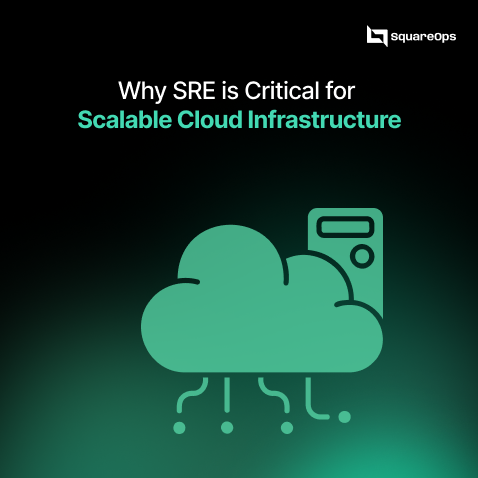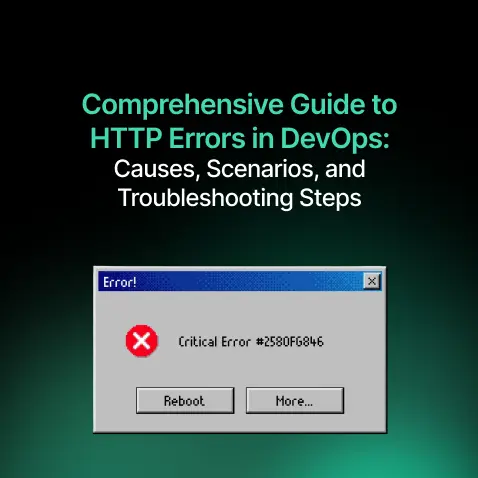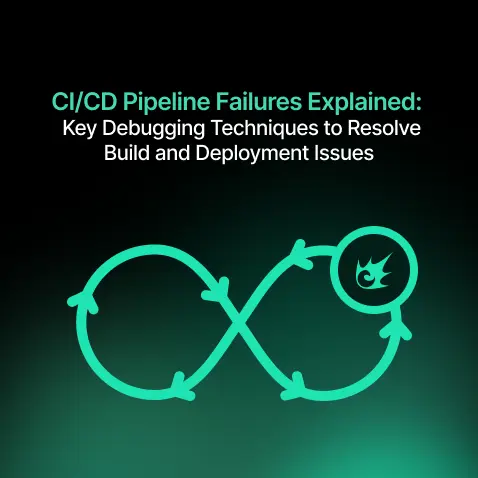Why SRE is Critical for Scalable Cloud Infrastructure
- Nitin Yadav
- Knowledge
About

Discover why Site Reliability Engineering (SRE) is critical for building scalable, reliable, and secure cloud infrastructure in 2025. Learn how SquareOps can help.
Industries
- CI/CD Pipelines, Cloud Security, DevOps, SquareOps, SRE, SRE tools, Terraform
Share Via
Introduction
With the rapid increase in use of the cloud, companies are confronted with a pivotal problem – how do you ensure high availability, reliability and performance as you scale? Traditional IT operations models are not sufficient in an era where downtime translates to loss of revenues and customer trust.
That is where Site Reliability Engineering (SRE) becomes very important.
Originally created at Google and now adopted across industries, SRE closes the gulf between development and operations, making sure that cloud platforms aren’t just scalable but stable, secure, and efficient.
In this article, we delve into what SRE is, the primary responsibilities of SRE teams, why SRE is crucial for scalable cloud infrastructure, the primary tools it uses, and where SRE is heading in the future.
What is SRE?
SRE is what happens when you ask a software engineer to design an operations function.
It works on creating and maintaining scalable and reliable systems and minimizes the operational overhead by implementing automation.
Origins and Principles
- Source: Created by Google in early 2000s.
- Objective: Like Twitter 2 Achieve and sustain scalable reliability while innovating fast.
- Core Principles:
- Adding more emphasis on automation to reduce manual work
- Establishing and tracking reliability targets for services (SLOs/SLIs)
- Favoring blameless postmortems and learning from those incidents
- Trade off of feature velocity and stability
Contrary to the traditional IT vendor model, SRE considers that operations is a software problem, and scales that way, that is, you use technology to scale, not people.
Core Responsibilities of an SRE Team
SRE teams have a democratized set of responsibilities to guarantee systems are reliable, scalable and their operational excellence:
- Emphasizing Scalable, Resilient Systems: Designing systems that can automatically grow to meet increasing customer needs, while remaining highly available.
- Defining SLIs and SLOs: You establish what to measure to reliably (such as availability, latency and throughput, etc.) and set a target for each such metric.
- Minimize Toil: Recognize repeatable tasks and script and automate with tools and IaC (Infra as Code) frameworks.
- Incident Response: Process and lead incident response including immediate and long term remediations.
- Performance Optimization: Real-time system performance monitoring, optimize resource usage and service configuration.
By reducing reliability to a quantifiable and managed property, SRE helps stabilize and improve cloud systems from the perspective of its most essential feature.
Why SRE is Critical for Scalable Cloud Infrastructure
Infrastructure that scales without sacrificing reliability is tricky. SRE offers techniques and a way of thinking to cope with such tradeoffs.
Managing Rapid Growth and Scaling
Modern cloud applications are faced with unpredictable traffic bursts, worldwide reach, and unpredictable scale.
How SRE Helps:
- Capacity Planning: Predict future needs and scale preemptively.
- 80 Service Scaling Model Auto-Scaling architectures – make use of AWS Auto Scaling, Kubernetes Horizontal Pod Autoscalers (HPA), or serverless infra to dynamically adjust capacity.
- Load Testing: Create the traffic spikes and simulate spike loads to validate your scaling strategy and prevent service outages.
Enhancing System Reliability and Uptime
High availability is no longer optional; it is a business imperative.
How SRE Helps:
- Proactive Observability: Use tools such as Prometheus, AWS CloudWatch, and Datadog to catch aberrations before they affect users.
- Self-Healing Systems: Programmatically replace instances, do database failovers or restart a service using Kubernetes and managed services.
- Disaster recovery planning: Plan multi-region, multi-availability zone deployments with fail-over strategy and have backup.
Bridging Development and Operations
Traditional silos between developers and operations teams hinder agility and innovation.
How SRE Helps:
- Service Ownership Models: Developer owns most operational responsibilities for a service they develop, SRE operates by best practices, and we’ll always look for some middle ground.
- DevOps Alignment: Promote DevOps culture, plus practices that are geared towards reliability, such as incident retrospectives and tracking SLOs.
- Collaborative Incident Response: Bloomerang – Standardize response processes between dev and operation teams.
Reducing Operational Toil
Engineering resources are wasted and errors are introduced when repetitive manual tasks are performed.
How SRE Helps:
- Automation: You utilize infrastructure as a code (Terraform, AWS CloudFormation) and configuration management tools (Ansible, Puppet) to automate your deployments, monitoring deployments, and scaling rules.
- Runbook Automation: Normalise recovery steps and automate responding as much as you can.
This decrease of drudgery frees engineering teams to concentrate on creativity and product advancement.
Key Tools and Technologies Used by SREs
SRE for SREs: How Google’s Site Reliability Engineering teams create high-quality services For SRE teams, a rich set of tools is key to delivering highly scalable, reliable cloud services:
- Prometheus
- Grafana
- Datadog
- AWS CloudWatch
- Incident Management:
- PagerDuty
- Opsgenie
- Atlassian Statuspage
- Infrastructure Automation:
- Terraform
- Kubernetes Operators
- Helm Charts
- Distributed Tracing and Observability:
- OpenTelemetry
- Jaeger
- Chaos Engineering:
- LitmusChaos
- Gremlin
These capabilities provide real-time visibility, proactive incident management and, scalable automation across clouds.
Challenges in Adopting SRE Practices (And How to Overcome Them)
Though the positive aspects of implementing SRE are numerous, there can be some difficulties for large companies with making the switch:
Resistance to Cultural Change
- The fix: Create awareness among teams that we are all responsible for reliability and perhaps incentivize SRE practices.
Defining Meaningful SLIs and SLOs
- Solution: Initially focus on user-oriented metrics (like availability, latency, and error rates), and iterate.
Managing Toil vs. Feature Development
Solution: Designate dedicated engineering time for toil-reduction work and reliability projects.
Scaling Incident Management
- Solution: Develop playbooks for how such incidents will be responded to, ensure you frequently have game day simulations and you really should invest in as much training as possible.
By considering these issues early on, teams are better able to gain the full range of benefits from SRE.
Future of SRE in Cloud Infrastructure
The following is how the role of SRE will change in response to cloud technology trends:
- Artificial Intelligence Driven Incident Prediction: Models will be developed using ML to predict incidents, so that preemptive actions can be taken.
- Self-Healing Architectures Systems will continue to self-diagnose and self-repair to an even greater extent without human intervention.
- Secured SRE: Implementing security practices (DevSecOps) into SRE practices to create resilient and secure systems.
- Growth beyond into FinOps and sustainability: SREs will be measured and managed for cloud ad cost optimization as well as carbon/electricity footprint for financial and environmental goals.
Those investing in mature SRE practices today will stand in good stead for a cloud-native AI-driven future.
Conclusion and Call-to-Action
Cloud-based infrastructure, that is scalable, reliable and affordable, is no longer a nice-to-have option, it is a must-have.
Adopting SRE practices means that you can scale with confidence without trading off reliability, security, or the experience of your users.
SRE helps organizations cope with complexity, rapidly implement new ideas, and maintain an operational standard to support the growth.
If you’re looking to add SRE to your strategy for cloud infrastructure, and you need to be sure you can to scale and stay robust for the long haul — SquareOps can assist.
Take the first step to a successful SRE foundation designed specifically for your business: Get in touch with SquareOps.
Frequently asked questions
SRE, or Site Reliability Engineering, is a discipline that applies software engineering principles to infrastructure and operations to build scalable, reliable systems
SRE ensures that cloud environments are highly available, resilient, secure, and capable of scaling efficiently while reducing operational risks and downtime
.
The key principles include automating operations, defining and tracking Service Level Indicators (SLIs) and Objectives (SLOs), reducing toil, and improving incident management processes.
While both aim to improve software delivery, DevOps focuses on collaboration between development and operations, whereas SRE emphasizes reliability, automation, and measurable service objectives.
Common practices include monitoring and observability setup, automated incident management, capacity planning, load testing, blameless postmortems, and infrastructure automation.
SREs use Prometheus, Grafana, AWS CloudWatch, PagerDuty, Terraform, Kubernetes Operators, OpenTelemetry, and Chaos Engineering platforms like LitmusChaos and Gremlin.
SREs follow well-defined incident management playbooks, use real-time monitoring, conduct blameless postmortems, and automate responses to minimize mean time to recovery (MTTR).
.
SLIs (Service Level Indicators) are metrics measuring reliability aspects, while SLOs (Service Level Objectives) define acceptable thresholds for those metrics.
SREs automate repetitive tasks, deployments, monitoring setups, scaling, and recovery processes, freeing up engineers to focus on innovation and system improvements.
SquareOps helps organizations integrate SRE practices by building scalable, resilient cloud architectures, setting up observability, automating operations, and improving reliability engineering processes.
Related Posts

Comprehensive Guide to HTTP Errors in DevOps: Causes, Scenarios, and Troubleshooting Steps
- Blog

Trivy: The Ultimate Open-Source Tool for Container Vulnerability Scanning and SBOM Generation
- Blog

Prometheus and Grafana Explained: Monitoring and Visualizing Kubernetes Metrics Like a Pro
- Blog

CI/CD Pipeline Failures Explained: Key Debugging Techniques to Resolve Build and Deployment Issues
- Blog

DevSecOps in Action: A Complete Guide to Secure CI/CD Workflows
- Blog

AWS WAF Explained: Protect Your APIs with Smart Rate Limiting
- Blog

